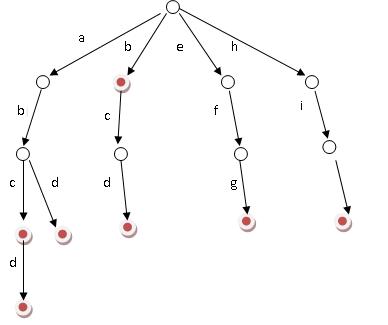Trie树就是字典树,其核心思想就是空间换时间。
举个简单的例子。
给你100000个长度不超过10的单词。对于每一个单词,我们要判断他出没出现过,如果出现了,第一次出现第几个位置。
这题当然可以用hash来,但是我要介绍的是trie树。在某些方面它的用途更大。比如说对于某一个单词,我要询问它的前缀是否出现过。这样hash就不好搞了,而用trie还是很简单。
现在回到例子中,如果我们用最傻的方法,对于每一个单词,我们都要去查找它前面的单词中是否有它。那么这个算法的复杂度就是O(n^2)。显然对于100000的范围难以接受。现在我们换个思路想。假设我要查询的单词是abcd,那么在他前面的单词中,以b,c,d,f之类开头的我显然不必考虑。而只要找以a开头的中是否存在abcd就可以了。同样的,在以a开头中的单词中,我们只要考虑以b作为第二个字母的……这样一个树的模型就渐渐清晰了……
假设有b,abc,abd,bcd,abcd,efg,hii这6个单词,我们构建的树就是这样的。

对于每一个节点,从根遍历到他的过程就是一个单词,如果这个节点被标记为红色,就表示这个单词存在,否则不存在。
那么,对于一个单词,我只要顺着他从跟走到对应的节点,再看这个节点是否被标记为红色就可以知道它是否出现过了。把这个节点标记为红色,就相当于插入了这个单词。
这样一来我们询问和插入可以一起完成,所用时间仅仅为单词长度,在这一个样例,便是10。
我们可以看到,trie树每一层的节点数是26^i级别的。所以为了节省空间。我们用动态链表,或者用数组来模拟动态。空间的花费,不会超过单词数×单词长度。
给出一个用类封装的字典树代码,厄。。。做ACM的模板用另一个。。应该放在了“ACM模板”文件夹下了。。。
 #include <cstdio>
#include <cstdio>
 #include <iostream>
#include <iostream>
 #include <cstring>
#include <cstring>
 using namespace std;
using namespace std;


 const int num_chars = 26;
const int num_chars = 26;



 class Trie
class Trie  {
{
 public:
public:

 Trie():root(NULL)
Trie():root(NULL) {};
{};
 Trie(Trie& tr);
Trie(Trie& tr);

 int search(const char* word, char* entry ) const;
int search(const char* word, char* entry ) const;
 int insert(const char* word, const char* entry);
int insert(const char* word, const char* entry);
 int remove(const char* word, char* entry);
int remove(const char* word, char* entry);
 private:
private:
 struct Trie_node
struct Trie_node


 {
{
 char* data;
char* data;
 Trie_node* branch[num_chars];
Trie_node* branch[num_chars];
 Trie_node();
Trie_node();
 }* root;
}* root;
 };
};
 Trie::Trie_node::Trie_node()
Trie::Trie_node::Trie_node()


 {
{
 data = NULL;
data = NULL;
 for (int i=0; i<num_chars; ++i)
for (int i=0; i<num_chars; ++i)
 branch[i] = NULL;
branch[i] = NULL;
 }
}

 int Trie::search(const char* word, char* entry ) const
int Trie::search(const char* word, char* entry ) const


 {
{
 int position = 0;
int position = 0;
 char char_code;
char char_code;
 Trie_node *location = root;
Trie_node *location = root;
 while( location!=NULL && *word!=0 )
while( location!=NULL && *word!=0 )


 {
{
 if (*word>='A' && *word<='Z')
if (*word>='A' && *word<='Z')
 char_code = *word-'A';
char_code = *word-'A';
 else if (*word>='a' && *word<='z')
else if (*word>='a' && *word<='z')
 char_code = *word-'a';
char_code = *word-'a';
 else return 0;
else return 0;


 location = location->branch[char_code];
location = location->branch[char_code];
 position++;
position++;
 word++;
word++;
 }
}
 if ( location != NULL && location->data != NULL )
if ( location != NULL && location->data != NULL )


 {
{
 strcpy(entry,location->data);
strcpy(entry,location->data);
 return 1;
return 1;
 }
}
 else return 0;
else return 0;
 }
}
 int Trie::insert(const char* word, const char* entry)
int Trie::insert(const char* word, const char* entry)


 {
{
 int result = 1, position = 0;
int result = 1, position = 0;
 if ( root == NULL ) root = new Trie_node;
if ( root == NULL ) root = new Trie_node;
 char char_code;
char char_code;
 Trie_node *location = root;
Trie_node *location = root;
 while( location!=NULL && *word!=0 )
while( location!=NULL && *word!=0 )


 {
{
 if (*word>='A' && *word<='Z')
if (*word>='A' && *word<='Z')
 char_code = *word-'A';
char_code = *word-'A';
 else if (*word>='a' && *word<='z')
else if (*word>='a' && *word<='z')
 char_code = *word-'a';
char_code = *word-'a';
 else return 0;
else return 0;


 if( location->branch[char_code] == NULL )
if( location->branch[char_code] == NULL )
 location->branch[char_code] = new Trie_node;
location->branch[char_code] = new Trie_node;


 location = location->branch[char_code];
location = location->branch[char_code];
 position++;
position++;
 word++;
word++;
 }
}
 if (location->data != NULL)
if (location->data != NULL)
 result = 0;
result = 0;

 else
else  {
{
 location->data = new char[strlen(entry)+1];
location->data = new char[strlen(entry)+1];
 strcpy(location->data, entry);
strcpy(location->data, entry);
 }
}
 return result;
return result;
 }
}
 int main()
int main()


 {
{
 Trie t;
Trie t;
 char entry[100];
char entry[100];
 t.insert("aa", "DET");
t.insert("aa", "DET");
 t.insert("abacus","NOUN");
t.insert("abacus","NOUN");
 t.insert("abalone","NOUN");
t.insert("abalone","NOUN");
 t.insert("abandon","VERB");
t.insert("abandon","VERB");
 t.insert("abandoned","ADJ");
t.insert("abandoned","ADJ");
 t.insert("abashed","ADJ");
t.insert("abashed","ADJ");
 t.insert("abate","VERB");
t.insert("abate","VERB");
 t.insert("this", "PRON");
t.insert("this", "PRON");
 if (t.search("this", entry))
if (t.search("this", entry))
 cout<<"'this' was found. pos: "<<entry<<endl;
cout<<"'this' was found. pos: "<<entry<<endl;
 if (t.search("abate", entry))
if (t.search("abate", entry))
 cout<<"'abate' is found. pos: "<<entry<<endl;
cout<<"'abate' is found. pos: "<<entry<<endl;
 if (t.search("baby", entry))
if (t.search("baby", entry))
 cout<<"'baby' is found. pos: "<<entry<<endl;
cout<<"'baby' is found. pos: "<<entry<<endl;
 else
else
 cout<<"'baby' does not exist at all!"<<endl;
cout<<"'baby' does not exist at all!"<<endl;

 if (t.search("aa", entry))
if (t.search("aa", entry))
 cout<<"'aa was found. pos: "<<entry<<endl;
cout<<"'aa was found. pos: "<<entry<<endl;
 }
}


PS:实现方法
http://met.fzu.edu.cn/eduonline/web/web/resources/articleContent.asp?id=346